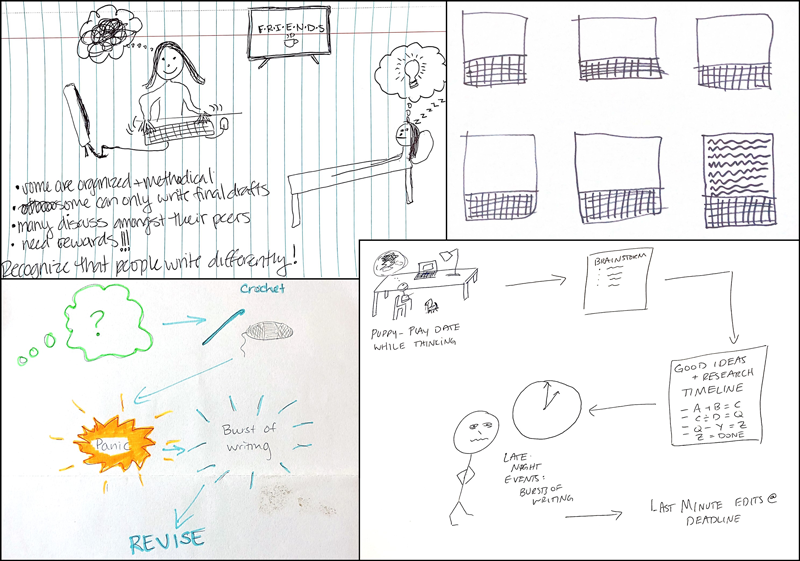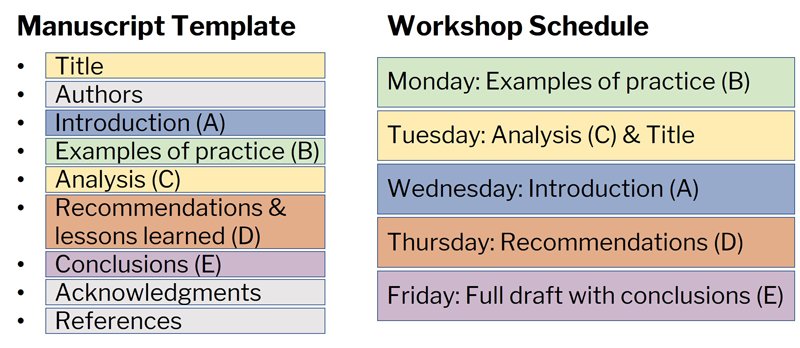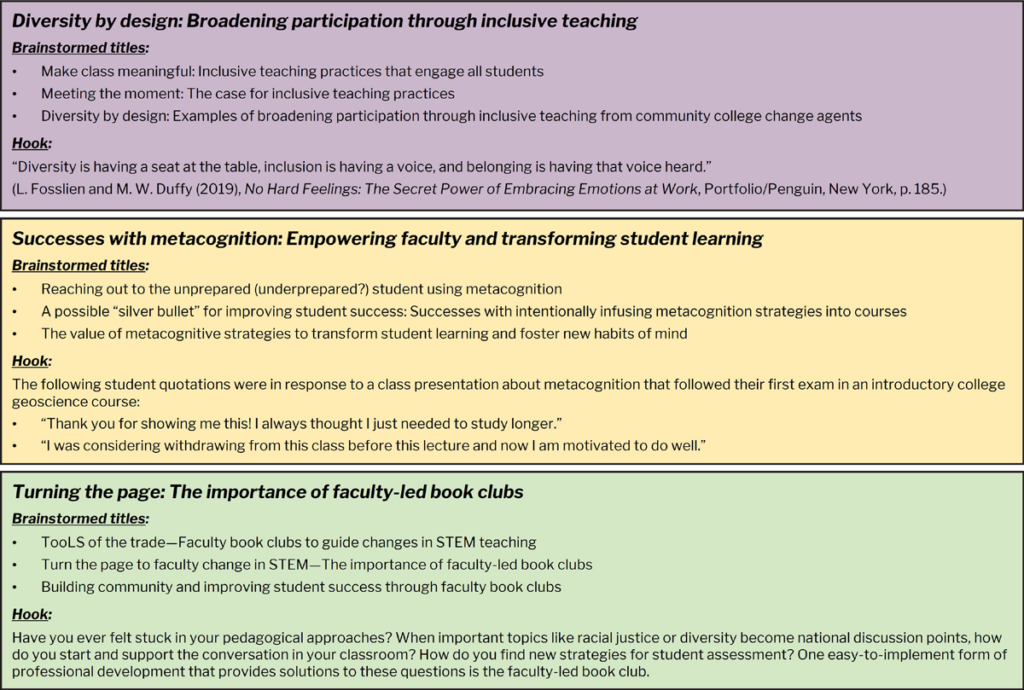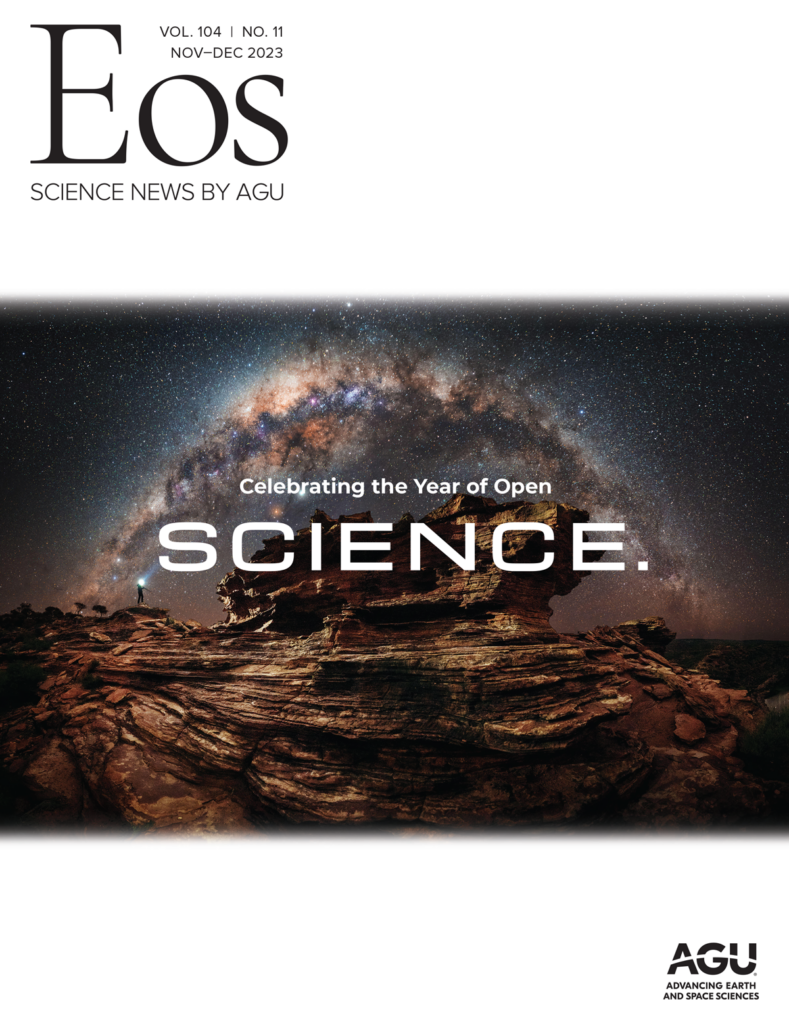Nearly all writers know the sensation as the cursor blinks starkly against the screen and pressure mounts. This uncomfortable feeling affects people of all ages, stages, and professions as they try to express their ideas in print—including scientists. Ernest Hemingway is often credited with saying, “There is nothing to writing. All you do is sit down at a typewriter and bleed.” If it were only that easy.
Scientific publications—whether traditional research articles or books, committee white papers, policy documents, or stakeholder reports—often involve multiple authors, which introduces additional challenges to the writing process beyond the fundamental difficulty of putting words on a page. These challenges, which include accommodating different timetables, approaches, and opinions, as well as navigating interpersonal dynamics, can sometimes slow productivity and lead to inequitable contributions and/or attributions in the end product.
To overcome barriers to writing, some people take advantage of writing retreats, boot camps, and accountability circles, which provide structured writing time and supportive communities providing tailored feedback. As researchers and educators familiar with the challenges of collaborative scientific writing, we incorporated and adapted approaches from these types of activities to design an innovative virtual workshop intended to make collaborative writing productive, equitable, and enjoyable.
The weeklong workshop involved more than 30 participants, including many novices to scholarly publishing, grouped into 10 writing teams. Its success was demonstrated by positive participant feedback and the fact that all 10 teams completed full manuscript drafts in just a week! A year later, the resulting papers had all been published.
In addition to its effectiveness in producing scholarly manuscripts, this workshop model could be adapted for other collaborative writing projects, scientific and otherwise. It could be used by researchers within lab groups, collaborating authors from different groups or institutions, and students in undergraduate and graduate courses.
Below, we describe the basic setup of the workshop and five key strategies we used to transform the task of collaborative writing and help writers overcome the blinking cursor.
Order from Messiness
Our workshop was organized through the Supporting and Advancing Geoscience Education at Two-Year Colleges (SAGE 2YC) project and focused on facilitating small groups of community college faculty to develop manuscripts for an issue of the journal New Directions for Community Colleges titled “Catalyzing Change: STEM Faculty as Change Agents.” The author teams, typically three or four faculty from different institutions who had participated in SAGE 2YC, met 4 hours a day in a 1-week virtual workshop that provided the necessary scaffolding to bring order out of the messiness of collaborative writing.
To form the author teams, participants first selected and prioritized subjects they were interested in covering in their manuscripts; the issue editors then arranged the teams based on participant responses. Before the workshop, each author completed a writing exercise describing their experiences with, for example, online instruction, inclusive teaching strategies, or undergraduate research with community college students. Then they shared their experiences, or “stories”—we deliberately used the word “story” to emphasize the narrative style we encouraged—with their coauthors to cross-pollinate and refine ideas. The teams built on these shared stories to draft each section of their article, and full drafts emerged as they worked through an iterative revisioning process.
Postworkshop support included a timeline with deadlines, individual consultations, online meetings to discuss progress, and low-stakes reviews of completed drafts before external review of their submitted manuscript.
Understand Writing as a Process
The notion of writing as a process may seem intuitive, but it is easily forgotten. Keeping it in mind can help writers remain patient and open to critical feedback.
Writing is more than typing words on a screen; it is a process of creating meaning that evolves as authors compose and revise. The writing process is often divided conceptually into three stages: (1) prewriting, which includes research and brainstorming; (2) composing, during which the structure of authors’ arguments emerges; and (3) revision, which includes re-visioning, or looking again to clarify the message among the writers and for their audience. Feedback throughout the process helps writers refine ideas. The notion of writing as a process may seem intuitive, but it is easily forgotten. Keeping it in mind—and thus reinforcing it in workshop settings—can help writers remain patient and open to critical feedback.
It is also important to convey that despite the simplified outline above, everyone’s writing process differs in the details. On the first day of the workshop, we prompted participants to think about and sketch their individual writing process. They then shared their process with the group, which illuminated the many different ways people approach writing (Figure 1). We learned, for example, that some people write best in the morning versus other times of day, and some begin with an outline, whereas others brainstorm through freewriting or concept maps.

Writers can be more effective if they understand their own process, and in collaborative writing settings, their expectations can be more realistic and flexible if they acknowledge and understand how the rest of their team approaches writing. They might even learn new strategies that work for them.
Brainstorm Through Freewriting
In freewriting, people write continuously for a specified amount of time, jotting down ideas as they come to mind without judging them or worrying about grammar and punctuation. Writing without self-censorship can help ideas flow and can overcome writer’s block. Freewriting is also a low-stakes way for writers to brainstorm and get feedback early in the writing process before they spend hours crafting individual sentences they may be reluctant to give up later.
Throughout the workshop, we gave participants short periods of time to freewrite in response to such prompts as the following:
- What are common threads among your team’s individual stories?
- Why is this work important? Why should the readers care?
- What are the biggest lessons learned from your topic?
“Freewriting prompts aligned our internal compasses. Even when we had different ideas about how to get from point A to point B, we at least all had common terrain in mind.”
After the time was up, each writer shared their ideas with their teammates, a process that was made easier because of the freewriting and that ensured all voices were heard. Many participants reported in daily road checks and postworkshop evaluations about the value of freewriting activities. For example, one person commented, “I sometimes think everything has to be perfect the first time. Freewriting allowed for writing without boundaries that I could go back and expound on later.” Another noted that “the quick writes…gave each of us a chance to write our own thoughts first (‘think, then share’).”
The sequence of individual writing followed by round-the-team sharing and discussion led to productive collaborative writing, galvanizing consensus among team members and spurring new ideas. As another participant said, the “freewriting prompts aligned our internal compasses. Even when we had different ideas about how to get from point A to point B, we at least all had common terrain in mind.”
Hold Off on the Introduction
An introduction is where writers articulate the purpose and vision of a manuscript for a specific audience, contextualize a hook to grab readers’ attention, and, in a collaboratively written piece, help multiple authors set a consistent tone and voice. The introduction is a crucial part of any publication, often determining whether people continue reading into the core discussion.
A common tendency is to want to write sequentially, from beginning to end. In some cases, though, the exact message of a manuscript may emerge to authors only after they have written and clarified arguments, examples, and analysis in other sections of the document. Thus, the introduction may best be written out of sequence.

We reinforced this point by having teams begin drafting their introduction on the third day of the workshop, after they spent time the first two days describing and sharing their stories and finding common themes and key points (Figure 2). In the opening session of day 3, the teams discussed the introduction’s purpose and importance. As their main arguments became clearer, authors then considered how to hook readers, first individually following a freewriting prompt (“How might you move the reader into the world of your chapter?”) and then as teams.
We encouraged them to be creative and provided an example of a successful paper that began with a quote and a hypothetical scenario to draw readers in. The authors generated many creative ideas for engaging audiences, including quotes, anecdotes, and scenarios (Figure 3). And we found that participants liked writing their manuscripts out of order. One commented that it was “hugely beneficial,” adding, “I’m a linear thinker, thus a linear writer, and can’t often get beyond the introduction and examples. I was skeptical at first about the order, but came to embrace it.”

Write for Your Audience
Effective writing is conversational in some ways, anticipating and providing the context needed by someone else to understand the substance and significance of the authors’ message.
Effective writing is conversational in some ways, anticipating and providing the context needed by someone else (i.e., an audience) to understand the substance and significance of the authors’ message. An important first step is to define one’s target audience (e.g., scientists, policymakers, the public) and intended outlet for publication, which will help authors tailor their arguments, style, and structure.
We stressed the idea of writing for one’s audience through several workshop activities. One focused on crafting successful titles, which give readers the first hint about the content and tone of a publication. In a fun exercise on the second day of the workshop, each team generated a few possible titles for their manuscript based on emerging themes from the day’s freewriting and discussions. Then other teams commented on the title options, indicating favorites and offering suggestions for improvement. By asking these external readers what they thought the article would be about, the participants discovered quickly whether their purpose was clear in the title.
Figure 3 shows several examples of final manuscript titles (in bold italic) that emerged after authors received feedback about possibilities brainstormed by their group. Some feedback, for instance, focused on keeping titles concise, more accurately reflecting the article’s content, and being more engaging.
As in other exercises throughout the week, this one gave writers immediate feedback on and audience reaction to their in-progress ideas, encouraging teams to make early revisions.
Honor All Voices
Viewing a topic from others’ perspectives challenges writers to examine their own assumptions and explanations and potentially reveals their own implicit biases. This is especially important for successful collaborative writing, in which coauthors share a common goal but may have different opinions about how to achieve it.
In our workshop, each writer shared ideas for a particular section of their team’s manuscript before the team drafted that section. After other brainstorming and freewriting sessions, team members similarly met to talk through their notes and agree on key points and promising ideas. To support equitable and inclusive collaborative writing, we provided teams with ground rules for these discussions, including listening actively and asking questions with the intention to learn, being respectful of others’ ideas and perspectives, and including everyone in discussions (i.e., speak up, step back).
Beyond these ground rules, we also asked teams to discuss author order and to set their own team norms, such as how they planned to handle differences of opinion about team decisions and deadlines. (One team suggested using the five-finger consensus.) And we encouraged teams to share information—about time constraints and conflicting obligations, for example—that would help them establish realistic writing schedules. They also discussed what their writing process sketches revealed to help them understand each other and work successfully as a team.
Furthermore, in some teams, participants took turns serving as an equity monitor, who was responsible for ensuring everyone had opportunities to participate. The structure of these discussions set the foundation for building a supportive writing community that honored all voices.
A Widely Applicable Model
Our focus on effective writing strategies and inclusive approaches to group work produced a community of writers working equitably and productively together.
Our focus on effective writing strategies and inclusive approaches to group work produced a community of writers working equitably and productively together. Participants’ feedback made clear that the following workshop characteristics were important in helping them feel respected and valued:
- providing explicit structure to the group writing process through planned activities, including dedicated brainstorming and writing sessions
- building in inclusive, nonhierarchical practices that encourage cross-pollination of ideas from all authors, enable real-time feedback, and reduce feelings of isolation
- acknowledging that writing is hard work while providing positive encouragement within a supportive environment, where critiques are constructive and build confidence
This workshop model is ideal for collaborative writing among authors with a range of experience, including student writers. Novice writers reported feeling comfortable sharing unpolished drafts and found early recommendations for revisions easier to incorporate.
More inclusive and equitable approaches to collaborative writing are likely to open paths to more diverse representation among authors. By following the strategies and advice described here, authors also may find the writing process smoother and more enjoyable. In addition, the finished products may end up clearer and more accessible, allowing findings and conclusions to be more easily applied in research, education, and policy.
Acknowledgments
We thank the workshop participants for their contributions to the workshop, supportive collegiality, and feedback. This work is supported in part by the National Science Foundation Division of Undergraduate Education through grants 1525593, 1524605, 1524623, 1524800, and 1835935. Any opinions, findings, conclusions, or recommendations are those of the authors and do not necessarily reflect the views of the National Science Foundation.
Author Information
Eric M. D. Baer ([email protected]), Highline College, Des Moines, Wash.; Karen M. Layou, Reynolds Community College, Richmond, Va.; and R. Heather Macdonald and Sharon L. Zuber, William & Mary, Williamsburg, Va.


